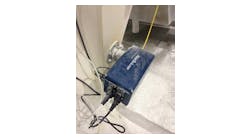Dilatant or shear-thickening materials are mixtures that exhibit an increase in apparent viscosity as the rate of shear increases. Typically made up of a high concentration of solids (polymers, metal or oxides) dispersed in liquid, these materials behave like a fluid under low-shear conditions but transition into a more solid-like behavior once greater stress is applied. At a certain point, when shear forces (those that push the particles together) become larger in magnitude than repulsive interparticle forces, the molecules shift from a layered to a disordered structure, causing an increase in viscosity. Generally, this process is reversible – when force from the stress dissipates, viscosity decreases and the material behaves like a fluid again.
The greater the shear applied to a dilatant material, the more resistance is encountered. When subjected to particularly high levels of stress or impact, highly dilatant materials can quickly become extremely rigid. It is this property that makes mixing dilatant formulations a unique challenge.
A planetary solution for dilatant materials
Understanding the phenomenon of dilatancy, one can deduce that the appropriate mixer for processing such materials must be relatively low speed and low shear. Yet, mixer speed cannot be too slow or else it will not be able to completely and thoroughly disperse the solid component. Some degree of shear is required for efficient mixing; therefore, the mixer must also have enough torque to accommodate the inevitable shear-thickening effects.
Figure 2. 200-gallon double planetary mixer
Various mixer configurations deliver low-shear agitation, from simple propellers and paddle blades to more complex counter-rotating agitators. However, these devices face a common limitation: viscosity. Especially when the starting liquid already possesses considerable viscosity, agitators with a fixed axis of rotation can be ineffective at solids dispersion. As more solids are added and concentration rises, dilatant behavior will set in, making it more difficult for the agitator to produce adequate flow.
The logical solution is to utilize agitators that move through the batch regardless of product flow. This is the forte of a double planetary mixer (DPM). It moves material by rotating two identical blades on their own axes as they orbit on a common axis. The blades continuously advance along the periphery of the mix vessel, removing material from the walls and transporting it toward the interior. The DPM delivers a kneading mixing action to high-viscosity dough-like materials, which enhances solids dispersion; it imparts gentle stirring agitation on low-viscosity slurries and thin pastes. In the mixing of dilatant products, the batching process could swing between these two rheological states due to mixer speed and solids loading at any given time.
Low speed yet powerful
A double planetary mixer is a robust machine capable of handling thick, sticky and highly filled materials as high as 6 million centipoise. It can also blend solids such as dense metal powders or pharmaceutical granulations. Powerful, variable-speed drives and heavy construction enable this type of mixer to deliver high torque throughout its entire speed range.
The comparatively low speed but thorough folding action imparted by the planetary blades is ideal for processing dilatant materials. A DPM can easily blend large amounts of solids into a viscous liquid vehicle and continue the dispersion process even after dilatant effects have set in. In 36 revolutions, the blades pass through every point within the vessel, physically contacting the entire batch. DPMs also allow for a more seamless scale-up transition, available in varying sizes from laboratory sizes, as small as half-pint capacity, and up to 1,000-gallon full product models.
Christine Banaszek is the sales manager at Charles Ross & Son Company, manufacturer of specialty mixing and blending equipment. As an application engineer at the corporate headquarters in Hauppauge, New York, she has worked at the Ross Test & Development Center and published many articles and white papers in mixing and blending technologies, applications and best practices. She holds a degree in chemical engineering.



